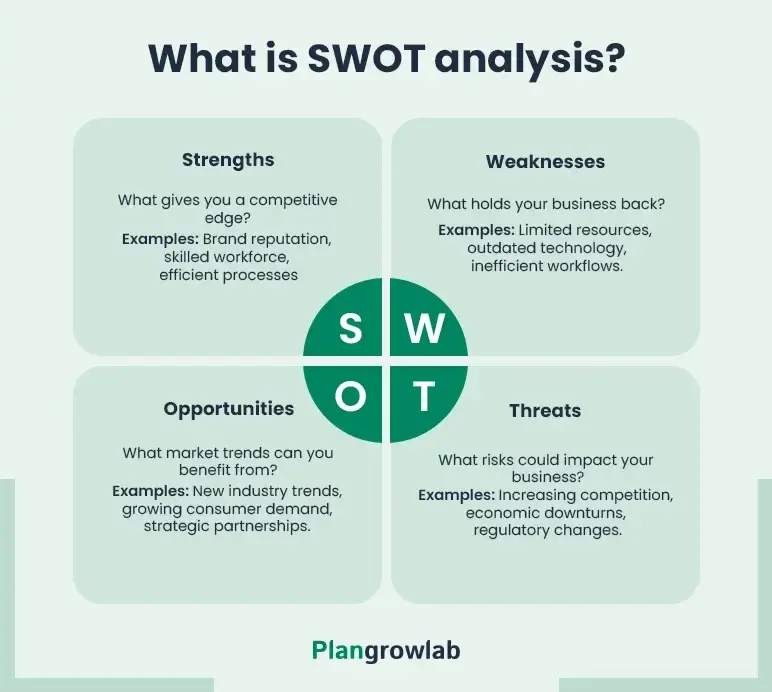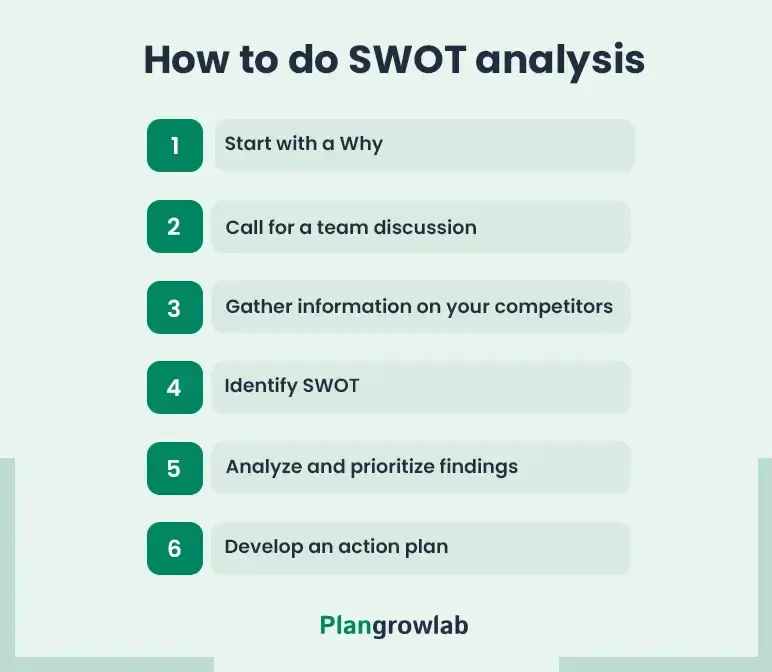Think your business idea is bulletproof? That’s great! But are you sure? Because running into supply chain disruptions, consumer behavior shifts, or a competitor landscape full of sharks might change your mind.
Will you be caught off guard? Not if you know how to do a SWOT analysis.
A comprehensive SWOT analysis makes sure you’re prepared for whatever comes next—good or bad. The goal is to avoid costly mistakes and identify opportunities before your competitors do.
In this blog, we’ll show you how to assess internal and external factors and conduct a SWOT analysis so you can make smarter business moves.
Let’s get started before that unexpected competitor does.
What is SWOT analysis?
A SWOT analysis, usually presented in a two-by-two grid, is a structured breakdown of a business's strengths, weaknesses, opportunities, and threats. This layout helps businesses see where their competitive edge lies and what risks they must address.
SWOT stands for strengths, weaknesses, opportunities, and threats—four areas every business needs to evaluate regularly.
- Strengths: Internal factors like skilled employees, strong branding, and operational efficiency.
- Weaknesses: Factors like source limitations or process inefficiencies that can hold your business back.
- Opportunities: Things that can fuel business growth like new markets, new technology, or expansion chances.
- Threats: Likely threats such as economic downturns or supply chain disturbance.

Now that you know what SWOT analysis in a business plan means, it’s time to put it into action.
How to conduct a SWOT analysis?
Here’s how to do your own SWOT analysis for a business plan:
1) Start with a “why”?
Why are you doing a SWOT analysis? If it’s because “everyone else does it,” take a step back. If it’s because you’re trying to gain a competitive advantage, fix weaknesses, or prepare for the latest trends, great! That’s exactly how a SWOT analysis should be used.
A good SWOT analysis process should lead to action. To make it effective, start with a clear goal—whether it’s improving operations, identifying growth opportunities, or tackling weaknesses.
Without direction, it’s just words on a page. When done right, it provides valuable insights that drive real business improvements.
2) Call for a team discussion
Your business strategy is only as strong as the insights behind it, so don’t limit your SWOT analyses to just one viewpoint. Bring in your sales and marketing team, human resources team, finance, and even customer support for a brainstorming session or two.
Trust me, they all see different opportunities and threats.
"Cross-functional collaboration can provide better business results at every level of work management, from discrete tasks to complex portfolio management," explains Lulu Richter, Senior Technical Project Manager at Smartsheet.
“For example, a designer might collaborate with a developer to adapt design requirements so that they consider the development level of effort. A sales representative provides strategic feedback to the product development team based on the conversations they're having with prospective customers.
The facilities team working to open a new regional office may consult with individual departments to understand how the space might be best configured to support their daily work."
Different teams offer unique insights that can seize opportunities, mitigate risks, and improve core processes. A good SWOT analysis includes multiple perspectives, so get everyone in the room and start the discussion.
3) Gather information on your competitors
If you don’t know where your competitors stand, how can you position your own business effectively?
Don’t just glance at your established competitors' websites—analyze everything. It can be their pricing models and product offerings. Subscribe to their newsletters, analyze their marketing campaigns, and read customer reviews.
Also, see if they’re gaining market share or struggling with the company's weaknesses. Do consumer trends align with their messaging? Even if you feel you know this already, validating your data helps avoid risky assumptions.
In the 1970s, Xerox overlooked rising competitors like Canon and Ricoh, who offered high-quality, cost-effective alternatives. To recover, Xerox launched the "Leadership Through Quality" initiative, analyzing competitor products and processes. It found that Japanese rivals could produce, ship, and sell copiers for the same cost Xerox spent on manufacturing alone.
This insight drove major improvements in manufacturing, quality control, and cost management, helping Xerox regain its competitive edge.
4) Identify SWOT
Be brutally honest if you want a SWOT analysis that actually improves your business strategy. Let’s go step by step.
Strengths: What gives you an edge?
✔️ A strong customer base and trusted reputation
✔️ Operational efficiency and well-structured internal processes
✔️ Skilled employees and strong leadership
✔️ Competitive pricing and innovative products
Weaknesses: Where can you do better? It could be:
❌ Weaknesses like outdated technology or slow workflows
❌ Business’s weaknesses in handling rapid growth
❌ Gaps in financial planning or budgeting
❌ Difficulty keeping up with changing market trends
Opportunities: Where should you focus? Some of the areas include:
✨ Consumer behavior shifts that favor your brand
✨ Emerging markets with high growth potential
✨ Outside opportunities to expand your product line
✨ New technology that boosts efficiency
Threats: What risks do you need to manage? It could be:
⚠️ Competitors trying to capture your audience
⚠️ Economic shrinkage affecting customer spending
⚠️ Potential threats like supply chain issues
⚠️ Changing regulations impacting operations
5) Analyze and prioritize findings
Not everything on your SWOT analysis list carries the same weight, so prioritizing is key.
How to analyze your SWOT findings?
- Rank the impact: Which strengths give you a serious competitive advantage? Which weaknesses are slowing you down?
- Look for patterns: Do your opportunities and threats overlap? Are your internal constraints stopping you from grabbing growth opportunities?
- Assess feasibility: What problems need quick fixes and what will take months of planning?
Prioritization process:
- Immediate actions: Quick fixes that improve efficiency right away (think fixing supply chain delays or streamlining operations).
- Short-term goals: The things that need some work but can boost strengths or reduce risks like investing in better tech.
- Long-term strategies: Bigger initiatives that take time but fuel long-term growth, such as expanding into new markets or improving financial forecasting.
A good SWOT analysis allows for strategic decision-making. Next, let’s turn these priorities into an action plan.
6) Develop an action plan
A SWOT analysis is only useful if you actually do something with it. Now that you know what to focus on, make a plan that ensures progress.
Here’s how you can turn SWOT analysis into action:
Maximize your strengths
Take what’s working and push it further. If you have a devoted customer base, engage them more through better communication and exclusive deals. If your business strategy is solid, optimize it to drive even better results.
Improve your weaknesses
Weaknesses are only a problem if ignored. If your team lacks technical expertise, train them. If you struggle with financial forecasting, get the right tools. Small improvements now prevent big headaches later.
Take advantage of opportunities
Industry trends change fast, so you have to be mindful of that. If you see an outside opportunity, go for it before competitors do. New demand? Offer the right solutions. Emerging technology? Use it to improve efficiency.
Reduce threats
Risk management is key to survival. If a new competitor is entering your space, prepare a differentiation strategy. If your industry is facing regulatory changes, adapt before they impact your SWOT framework.

With a proper SWOT analysis, you can write your business plan with a comprehensive perspective, ensuring a clear strategy that covers all aspects of your business
But, a SWOT analysis is only as good as the questions you ask. If you don’t dig deep, you’ll end up with surface-level insights that won’t help you develop strategies.
Questions to ask when conducting a SWOT analysis?
Your SWOT analysis covers a lot, but are you really asking the right questions? Here are the key questions to ask at every stage of your SWOT analysis so you can make real strategic decisions.
Strengths
- What are our company’s strengths, and how do they give us an edge?
- What unique internal factors contribute to our success?
- Why do customers prefer us over competitors?
- What internal resources or expertise do we have that others don’t?
- How do we consistently outperform the market?
Weaknesses
- What weaknesses negatively impact our business?
- Where are we losing customers, and why?
- What do competitors do better than us?
- Do we lack key skills, technology, or resources?
- What inefficiencies exist in our business operations?
Opportunities
- What external factors are creating new business opportunities?
- Are there market trends we should capitalize on?
- Can we expand into new regions or industries?
- What collaborations or partnerships could strengthen our position?
- How can we use technology to improve efficiency and scalability?
Threats
- How are competitors evolving, and are we keeping up?
- Are there regulatory changes that could affect our business?
- Could technological shifts disrupt our industry?
- Are economic conditions creating potential risks?
- What external threats should we prepare for now?
Simply knowing your company’s strengths, weaknesses, opportunities, and threats isn’t enough. You need to apply those insights to real planning.
How to use SWOT analysis in business planning?
Knowing how to do a SWOT analysis for a business plan is just as important as conducting one. Let us break down how to effectively use a SWOT analysis in business planning to create a roadmap for success.
1. Make smarter business decisions
A SWOT analysis helps business owners avoid common planning mistakes. Analyzing it ensures you focus on what actually works and prevents missteps by identifying potential weaknesses before they become problems.
2. Build a plan that works
A small business thrives when its goals match its resources. Identifying internal strengths ensures you’re not overextending resources while setting goals. When your organization's strengths align with your business vision, achieving success becomes much more realistic.
3. Strengthen market position
Knowing your strengths allows you to create a strong brand identity. Businesses that emphasize an organization's strengths in their business and marketing business planning attract better opportunities and customer loyalty.
4. Keep up with market changes
Your business landscape is always evolving. Regular SWOT analyses help you adjust pricing, marketing, and product strategies to stay competitive. Businesses that adapt early thrive, while those that don’t risk becoming irrelevant.
5. Get ahead of business risks
Ignoring business threats won’t make them disappear. A SWOT analysis helps you manage risk effectively by identifying financial, operational, and industry-related challenges before they cause major problems.
Understanding how to write a SWOT analysis is great, but applying it is what really matters. A SWOT analysis example will show you exactly how businesses use this framework.
SWOT analysis example
Real businesses use SWOT analysis to make informed decisions. Let's consider Walmart, one of the biggest retail giants. Before expanding into new global markets and strengthening its eCommerce presence, Walmart conducted a SWOT analysis to ensure it was heading in the right direction.
- Strengths: Walmart is a household name, particularly in the US, Canada, Japan, Korea, and China. Customers associate it with affordable pricing, convenience, and an efficient supply chain. With a diverse revenue model spanning physical stores and digital services, Walmart had a strong foundation for growth.
- Weaknesses: Despite its global presence, Walmart remained heavily reliant on the US market, with nearly 45% of its stores located there, making it vulnerable to economic downturns. Also, its eCommerce presence lagged behind Amazon, and ongoing concerns over labor practices affected its public image.
- Opportunities: Walmart saw potential in expanding into Asia, Africa, and Australia to diversify its market presence. Strengthening its eCommerce platform and introducing sustainable, eco-friendly products also became key priorities to align with shifting consumer preferences.
- Threats: Competitors like Amazon, Costco, and Target were already dominating online retail, while customer expectations were shifting toward sustainability and premium goods. Without rapid adaptation, Walmart risked losing market share.

Using these insights, Walmart accelerated its eCommerce expansion, optimized its supply chain for digital efficiency, and expanded its sustainable product offerings to meet consumer demand. It also tailored its global expansion strategy to ensure alignment with local market needs.
We’ve walked through how to do a business SWOT analysis, but let’s talk about what not to do.
SWOT analysis mistakes to avoid
Avoiding common pitfalls ensures your findings lead to actionable and effective strategies. Here are five key mistakes to watch out for:
1. Turning actions into opportunities
“Expanding into new markets” isn’t an opportunity. It is a strategy. Real opportunities are external factors like market growth or emerging trends. Stick to facts, not plans.
2. Keeping it too general
“Slow delivery times” is vague. Be specific—what’s causing the delay? Is it poor logistics or a lack of manpower? Precision makes solving the problem much easier.
3. Ignoring the context of competition
Failing to assess your opportunities and threats in relation to competitors weakens your analysis. Always compare core capabilities to the competitive landscape and use frameworks like PEST analysis to include external dynamics.
4. Overcomplicating the analysis
Endless lists can overwhelm rather than clarify. Summarize key insights from brainstorming sessions to create a concise and effective SWOT analysis that is easy to use and understand.
5. Not revisiting the analysis regularly
Your first SWOT analysis isn’t your last. Failing to repeat your SWOT analysis means missing new risks or opportunities, making your strategy outdated. Update your analysis regularly to stay relevant.
For instance, Kodak failed to update its strategic analysis, ignoring the rise of digital photography despite inventing the first digital camera in 1975. This reluctance to shift from its profitable film business led to a sharp decline, resulting in bankruptcy in 2012.
A SWOT analysis is an ideal way to go about business strategic planning, but its impact heavily depends on how effectively the company executes it. To get the most out of it, businesses should avoid the common mistakes that we listed above.
The bottom line
A SWOT analysis is a good place to begin more effective business planning, but it's only the beginning. It provides you with clarity on where your business is so that you can discuss major strengths, internal weaknesses, and external opportunities and threats.
You’ve done a SWOT analysis, so you now have a neat list of things your business is great at—and a few things that need work. Identifying strengths and weaknesses isn’t enough. You need to translate those insights into action.
If you’re an entrepreneur looking to turn your SWOT findings into tangible results like securing funding, attracting investors, or scaling operations, Plangrowlab has you covered.
Our expert business plan writers craft SWOT-driven strategies to highlight advantages, mitigate risks, and align opportunities with actionable goals.
SWOT is just the first one. Plangrowlab helps you achieve real business growth.
Frequently Asked Questions
When should you use a SWOT analysis?
Apply a SWOT analysis prior to taking any company action, whether that means venturing into new projects, overhauling internal policies, looking at chances to shift directions or changing a plan halfway through its implementation.
What are the five elements of a SWOT analysis?
A SWOT analysis has four core elements:
- Strengths
- Weaknesses
- Opportunities, and
- Threats
But the fifth element is often Action.
How does a SWOT analysis help a business plan?
A SWOT analysis helps in adjusting business processes and plans for growth by assessing core strengths and weaknesses alongside opportunities and threats.
How to use a SWOT analysis?
To use a SWOT analysis:
- Identify strengths
- Recognize weaknesses
- Spot opportunities
- Assess threats
- Turn those insights into action.

